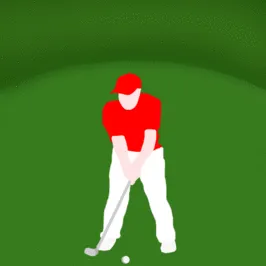Spine Mobility Limits the Turn for Most Golfers
One of the biggest thing that golfers tell me is that their back is really tight and they aren’t able to make a turn on the ball very well. Often, because of that tightness and lack of turn, it leads to them feeling like they come out of posture during their swing.
The spine is made up of the neck, the upper/middle back and the lower back regions. The mobility we need in our golf swing comes from all of these different regions in the spine – if one of them isn’t moving well, that’s going to put more stress on other parts of the spine during the golf swing.
We will discuss the neck in a future post in this series, but for today we will focus on the combination of the middle back and the lower back regions.
What can we do to improve our spine mobility for our golf swing?
To check your flexibility of your spine, simply sit in a chair, keep your legs together (don’t let them come apart), cross your arms over your chest with your hands on your shoulders and turn as far as you can to your left and then to your right. Do you pass this test? Check your results here.
Are you able to turn your spine 60 degrees to the left and then 60 degrees to the right? Be honest! This is a common area for people to feel like their obliques will cramp when they try to rotate as far as they can with this test. This test can really expose whether you have a problem with your backswing or into your downswing dependent upon how well you can rotate (turn) your spine.
This is the second most commonly failed tests for golfers and can greatly impact longevity of play. Men over 40 tend to have the greatest issue with this test. However, women can be effected in this area as well.
Your Solution

So what can we do to improve our spine mobility and get your swing back on track?
- First we need to be able to expand our ribcage well with our breath. Yes, you read that right. It may seem strange, but a really rigid ribcage will impact how well the spine can turn and it will affect how a lot of the core muscle can be used to create a turn. Once we are able to expand our ribcage well (and as a result, a lot of nagging shoulder blade pain will be resolved), we now have a good chance of turning better with ease.
- Next, we may need to work the rotational flexibility of the thoracic spine and the flexion and extension (bending forward and backward) as well – but, as with any training, that will be unique to individual needs.
- Once we’ve gone through building these components, we’re now looking at building core strength and stability and this will tie into how the pelvis and hips move as well as how stable the lower back is. We do NOT want the low back to be where we get our flexibility in our golf swing — unfortunately, this can happen when the mid back and the hips are tight and stiff.
Finally, we build on coordination and implementation into the golf swing – this again, will be unique to each individual golfer with what this will look like.
If you haven’t already, checkout our golf home assessment to see where you match to other golfers like you
Remember to start working on improving your flexibility/mobility and strength little by little – you don’t need to do an hour of exercises each day. Start small with what you can consistently do for 5-10 minutes each day. Consistency over time with the right exercises will lead to improvements and results. If you can get 45 minutes a week working on your spine (preferably not at one time, but spread out throughout the week), that’s all you will need to start seeing results!
More Resources
What’s Next?
Losing flexibility is something that DEFINITELY happens as we get older — BUT a lot of your flexibility problems can actually be prevented and/or decreased in severity. There will be more articles coming up soon going into more discussion about things you can do and exercises you can try to help with your flexibility and mobility – so stay tuned!
Dr. Grant Bishop, PT DPT, TPI Certified
Follow Dr. Grant and the CTG Golf Program on FB and IG or check out our Golf Therapy and Training Offerings.
Don’t forget about Registering for our FREE workshop on golf flexibility:



